Introduction to Ha Giang Vietnam: Ha Giang province is in the northeast of Vietnam and includes the country’s northernmost point. In any forum about traveling far north of Vietnam, you can rest assured that people are speaking of Ha Giang. With the mesmerizing natural scenery and unique ethnic culture of the highlands plus the thrilling roads, this northern destination can perfectly please adventurers, nature lovers, and thrill-seekers. Gifted with the extraordinary geological structure, the province owns wonderful potential for ecotourism and trek tours that no other place can compete. This is also where you find the unique Dong Van Plateau Geopark recognized by UNESCO. Other attractions include the breathtaking peaks, ancient towns, ethnic market, Lung Cu Flagpole, Ma Pi Leng Pass, Palace of the Hmong King, etc. It is the only destination in Vietnam where you can find the best mountains to fulfill your trekking passion. Make sure to fully charge your cameras to be ready for the awesome shots. Read on for more introduction to Ha Giang.
Overview of Ha Giang
About its administrative divisions, Ha Giang consists of 1 city and 10 rural districts. Also, its provincial capital is named Ha Giang, which is around 320km away from Hanoi. Due to the mountainous topography and low potential to develop agriculture, Ha Giang is among the poorest provinces of Vietnam, yet its natural beauty is on top. The population here is not large, yet the majority are the ethnic people of Hmong, Tay, Dao, Nung, Lo Lo, etc. These ethnic groups engage in ancestor and spirit worship. Also, Ha Giang hosts many cultural festivals in the presence of over 20 ethnic minorities; each of the groups preserves their art, weaving, and hand-made textiles. For example, the Hmong and the Dao tribes celebrate their Spring Festival (shortly after the Vietnamese Lunar New Year or Tet), which runs between three and seven days. Their celebration includes singing, feasting, and drinking alcohol. The northernmost province is known for the magnificent mountainous landscape mixed with the endless terraced rice fields and the purple buckwheat flowers that color the hills. Along with that, the well-preserved culture and traditions of the ethnic minority group do attract explorers all over the world.
Geographical Location
Ha Giang is called Vietnam’s final frontier as it shares a 270km long border with Yunnan province of southern China. It’s bordered by the provinces of Cao Bang (in the east), Lao Cai and Yen Bai (in the west), Tuyen Quang (in the south), and the Chinese border (in the north). Its topography has numerous mountains, springs, and limestone formations. Along with that, the Lo River and Mien River are the significant rivers of the province, which support the locals’ life and establish marvelous views from the top dimension. Regarding the mountains, the two tallest peaks are Tay Con Linh (at a height of 2,419m) and Kieu Lieu Ti (at a height of 2,402m). Thanks to the pristine natural conditions of forests, Ha Giang is home to over 1,000 species of herbal plants and fauna. As much of the destination is too mountainous to grow rice, the land remains covered by forest. Its central plateau, however, can grow tea, plums, peaches, and persimmons. The roads in Ha Giang have been famous for the winding and bumpy conditions which create inspiring challenges for drivers. Yet the enchanting beauty of the highlands is worth a trip as the sightseeing pastime goes perfectly.
Weather Characteristics
The climate of this mountainous province is noticeable for the cold characteristics compared to the lowlands and adjacent midlands. Its average annual temperature is 21 – 23 Celsius degrees. It features the high humidity throughout the year, plus the abundant and prolonged rain. In each month of the year, the destination owns distinctive beauty, so you can travel to Ha Giang any time you feel like. During the exploration, you will come across some roads running toward the clear blue sky or the terraced rice fields which seem to be endless. The destination is not only famous for the majestic scenery, but also for the colorful kinds of flowers which can be the yellow cabbage, the purple buckwheat flower, and pure white plum flower.
Introduction to Ha Giang ‘s Best Time to Travel
When is the best time to travel to Ha Giang? The answers to this question might vary, and of course, you can tour Ha Giang any time of the year, but the best time is the harvest season (October, November, and December). It is when the buckwheat flowers and cabbage fields bloom and illuminate the whole mountainous region in gorgeous colors. September and October are the autumn months when the terraced rice fields and the valleys are covered by the picturesque yellow of the ripe rice. Ha Giang harvest season has been famous among the landscape photographers who gather for the best arts of life. Also, from the end of October to December, groups of backpackers start their journeys to Ha Giang to marvel at the purple buckwheat flowers spreading all over the hills and slopes. There is even the Ha Giang Buckwheat Flower Festival taking place every autumn (around November). When talking about the grand beauty of this iconic flower, people promptly think of Ha Giang. Another good month is to go is January, when the cherry blossom, plum, and cabbage flowers show their beauty and color the regions from Quan Ba to Yen Minh, Dong Van, and Meo Vac.
In sum, it’s best to visit Ha Giang in three seasons. First, the season of the buckwheat flower and cabbage flower runs from October to November. Second, the rice harvest season in Hoang Su Phi is from September to October. Third, the season of the plum flower and cherry blossom flower is January of the lunar month.
Ha Giang History and Development
The French colonial period
In 1886, the region was occupied by the French that built their military garrison on the eastern bank of the Lo River. This sector later functioned as one of the four main military bases of French Indochina in North Vietnam by the year 1905. From 1913 to 1915, the Vietnamese Dao tribes rebelled and fought against the French colonial rule, following their slogan “No taxes for the French, defeat the French out of the country for the Dao’s liberty.” The rebellion expanded to Lao Cai and Yen Bai provinces. However, in 1915, it was ruthlessly suppressed.
Hmong Lords
The northern regions of Ha Giang bordering China (namely Dong Van and Meo Vac) were dominated by the Hmong people from the late 18th century. It was the Vuong family of the Huang clan that ruled these regions. During the French colonial period, the Hmong Lord was further supported by the French to maintain their control of the border territory. In 1990, Vuong Chinh Duc was made the king of the Hmong people. Then, the king’s palace was constructed between 1092-1903 by the Chinese architects. The Hmong Lord was so loyal to the French that he supported them to defeat the tribal rebellion. Later, in 1944, Vuong Chu Sen succeeded his father. The new king was pledged to support President Ho Chi Minh in the fight against French colonial rule.
Modern Ha Giang
Ha Giang Province today has 1 city and 10 rural districts. The city is named Ha Giang while the 10 rural districts are Bac Me, Dong Van, Hoang Su Phi, Meo Vac, Quan Ba, Quang Binh, Xin Man, Vi Xuyen, Bac Quang, and Yen Minh. In total, it has 156 communes, wards, and hamlets, of which 112 communes have difficult situations. The northernmost destination remains pristine, untouched, and far away from the lines of tourists. People merely know that Ha Giang owns the most beautiful terrace rice fields in Vietnam, but not many know exactly where and how to access the site. Thanks to the digital transformation and online media nowadays, the fame of Ha Giang better reaches the communities that people come to know that September and October are the ideal months to get there. The local travel firms and organizations have been making short videos about the local landscapes, uploaded them to social media networks, and helped attract more visitors.
Recently, the province has had two traditional ceremonies inscribed on the list of Vietnam’s national intangible cultural heritage. The newly inscribed heritages include 1) the ceremony to pray for bumper crops (the new corn ceremony) of the Red Co Lao ethnic group in Tung San commune, 2) the Ban Vuong worshipping ceremony of the Red Dao ethnic group in the Ho Thau commune. While the new corn ceremony is dedicated to showing gratitude to gods and ancestors for blessing the favorable weather and bumper crops, the Ban Vuong worshipping shows people’s respect for ancestors and pray for peace, prosperity, and fruitful harvest. At present, Ha Giang is home to 19 ethnic groups and hosts 27 national intangible cultural heritages.
Introduction to Ha Giang’s Means of Transport
If you’re coming to Hanoi from northern Vietnam, there are public coaches running on a direct route. Otherwise, if you get started from southern or central Vietnam, your journey should begin from Hanoi capital city. From Hanoi, there are many coaches departing from stations of My Dinh, Luong Yen, Luong Nghia, or Gia Lam, which run directly toward Ha Giang province. You can opt for the coaches with beds or high-quality limousine cars, depending on the budget. Anyway, it’d be beneficial to get on the night coaches to save your time and energy. In general, the Hanoi – Ha Giang coach ticket ranges from 200,000 to 300,000 VDN per way. For example, if you depart at 08:00 PM from Hanoi, then you will arrive at 05:00 AM in Ha Giang. Upon your arrival to the province, you can hire a motorbike (if you can drive) to explore the destination and several adjacent landmarks in a day. Otherwise, pay for a taxi service, which is safe and worth the money.
If you book a Vietnam tour to Ha Giang, you will be not worry because the package includes transfer with driver, tour guide, etc.
Introduction to Ha Giang ’s Most Famous Attractions
The attractions in Ha Giang are located a bit far from each other; therefore, tourists should choose an itinerary of at least 3 days 2 nights to have enough time for initial exploration. The highly recommended packages are 4 days 3 nights or even 5 days. If you ask for the Top 3, here are the names: Ma Pi Leng Pass, Lung Cu flagpole, and Dong Van Ancient Town.
Ma Pi Leng Pass
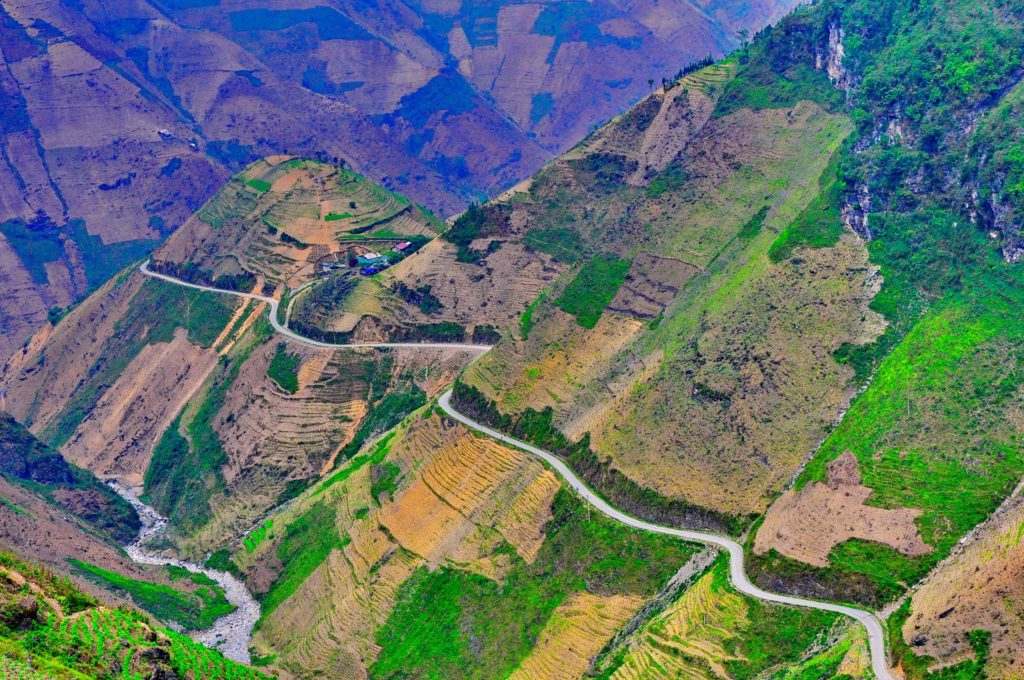
Ma Pi Leng Pass is the first and foremost attraction you must see in Ha Giang. The breathtaking pass connects the district of Dong Van and Meo Vac in a length of 20km. It has an elevation of 2,000m above the river. The magnificent scenery from the pass moves beyond human imagination ability. It is an art of nature that mankind could never compare. The colors of green, blue, yellow, brown, etc., all are combined artistically to result in impeccable pictures of nature that surprises the sightseers. There would be moments you’re wondering how Nature could draw such beautiful art in real. From above, you can spread your eyes toward the awesomely majestic view of the limestone cliffs and Nho Que river cutting through the valley beneath. While Ma Pi Leng Pass is a perfect venue for hikers, trekkers, and nature photographers, the Nho Que River encourages water activities of kayaking, boating, and swimming. You’ll be surrounded by the natural beauty of sky, clouds, mountains, and rivers, which are all perfect for sightseeing and photography. What’s more, at the foot of the pass is where you find the “Museum of Happiness” and learn about the harsh history of the construction of the 4C National Highway from Ha Giang city to Dong Van and Meo Vac. Sunset watching from Ma Pi Leng will be imprinted on the mind. It is also one of the four best passes of northern Vietnam.
Hoang Su Phi
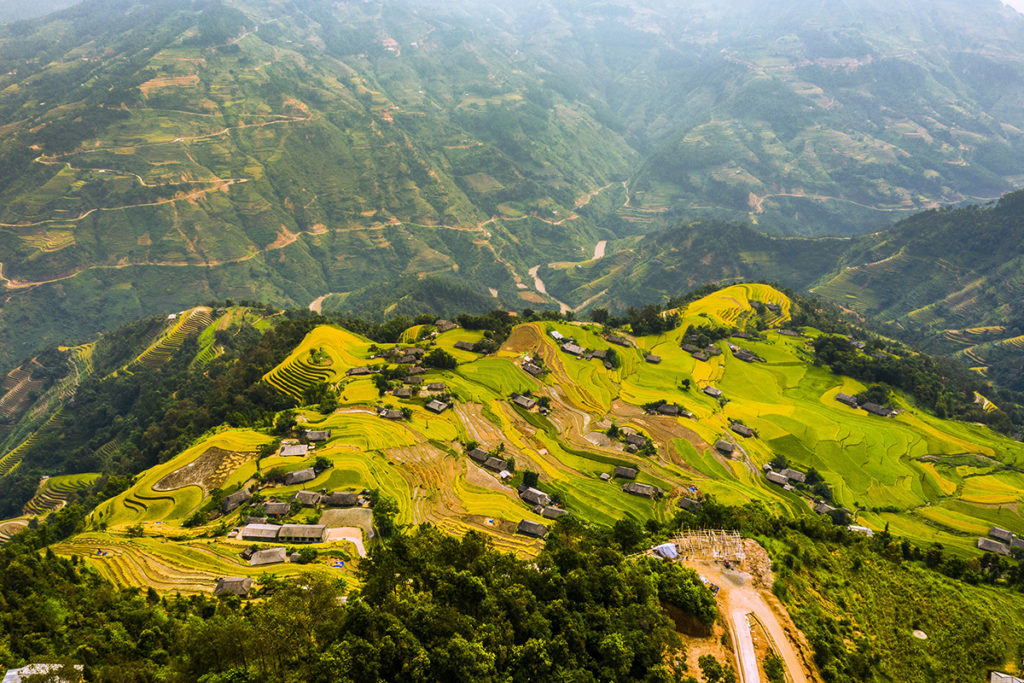
Hoang Su Phi is a district of Ha Giang and includes 6 rural communes. It’s around 80km from the town center. It’s known as a wonderful spot for sightseeing the giant terraced rice fields during the yellow harvest season. Hoang Su Phi terraced rice field is ranked the best in Vietnam and recognized as a national heritage. Other highlights of this region include the ethnic culture and primitive mountains. The area remains unspoiled and beautiful with original charm. A trekking tour to Hoang Si Phu often includes an overnight stay in the local homestays. There is one harvest season per year, so if you want to admire the golden fields, you should choose the right time. The best months are September and October when the rice turns ripe in yellow. The harvest starts in October. Other months like March and May give the region the lush look during the water season. Getting there, you won’t want to miss the ethnic market in Hoang Su Phi, held once a week on Sundays. It is where people come to sell goods like clothing, fabrics, vegetables, and agricultural tools. You can expect to meet the ethnic boys and girls being in their colorful costumes,
Dong Van Karst Plateau UNESCO Global Geopark
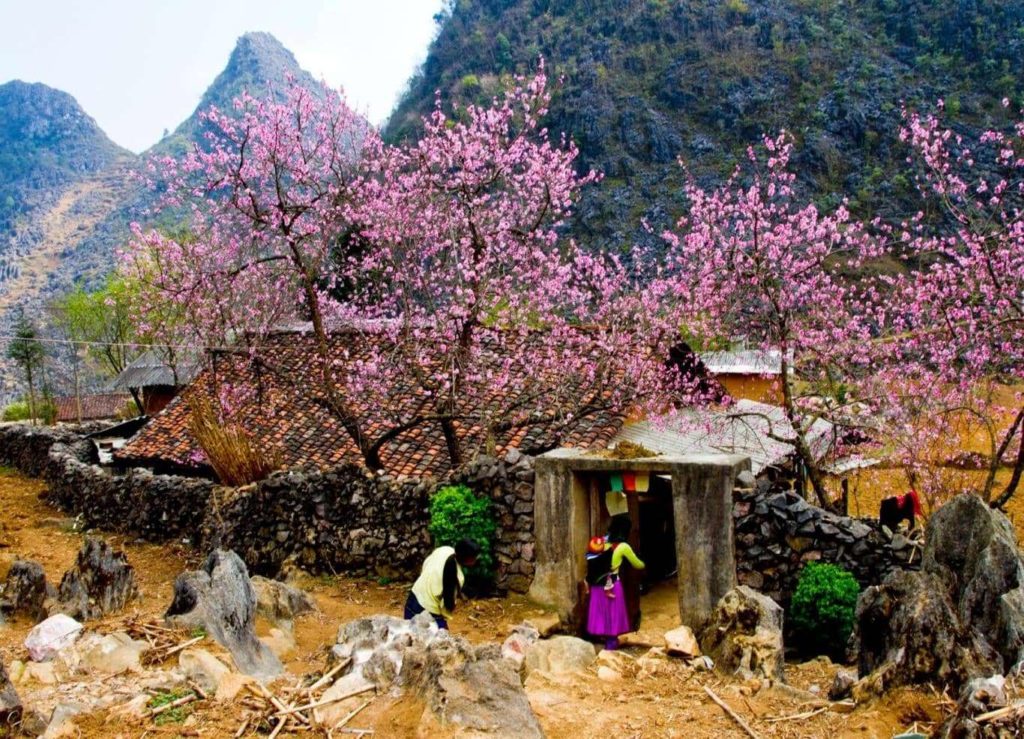
Located in the northeast of Ha Giang, Dong Van Karst Plateau UNESCO Global Geopark is a protected heritage with nearly 80% limestone surface and unique landscapes of high mountains and deep canyons. Its tallest peak is Mieu Vac Mount (1,971m high) and the deepest canyon is Tu San (700-800m deep). Besides the unbeatable geological values recognized by UNESCO, this heritage site is home to the rich flora and fauna, of which some are endangered. Also, the karst plateau is inhabited by 17 ethnic groups (Hmong, Dao, Lo Lo, Tay, Nung, etc.), who preserve their traditions, culture, and customs that result in the rich cultural heritage of the site. There have been educational attempts to better promote tourism in the geopark via panels, guidebooks, brochures, posters, visual aids, and local presenters. The activities bring good results in increasing the locals’ and visitors’ awareness of the significance of the UNESCO site. Sustainable tourism helps better the lives of the ethnic groups in the area. As a member of the UNESCO Global Geoparks Network and Asia Pacific Geoparks Network since 3 October 2010, Dong Van Karst Plateau Geopark has been a pride of Ha Giang and Vietnam.
Dong Van Ancient Town
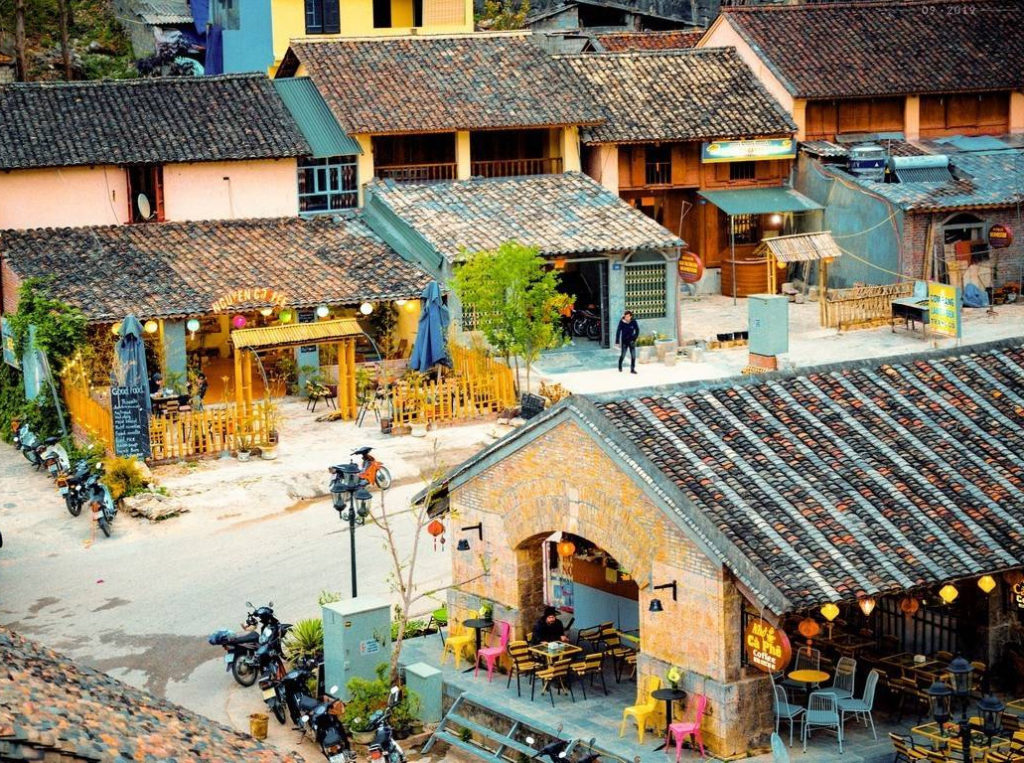
Established in the early 20th century, Dong Van Ancient Town is included in the tourism complex of Ha Giang. The town was initially inhabited by a few Tay, Chinese, and Hmong families. Later, the Kinh, Dao, and Nung came to join the community. The old quarter of Dong Van hosts around 40 age-old houses and ethnic markets. Generations of the ethnic groups preserve their traditions, customs, and folk songs. At night, people use red lanterns to illuminate their houses and display their brocades for selling to tourists. They can also serve corn wine and Thang Co (horse meat soup). The locals also consider it as a festival venue where the young ethnic individuals dressing in their traditional costumes come to the Dong Van market to make friends, shop, and exchange goods. To serve tourists nowadays, the old Dong van market was moved behind the town. Instead, some coffee shops in the traditional architecture have been designed. A walk around the town in the evening provides a beautiful glimpse of the ethnic lifestyle that you can only find in the far northern area. Getting there, you’re likely to meet alike foreigners, landscape photographers, and Hmong kids who are carrying a full-of-flower-and-grass basket. This tourist attraction features the time-stamp Chinese architecture and the traditional ethnic culture of the Hmong people, which are precious properties nowadays.
Meo Vac Market
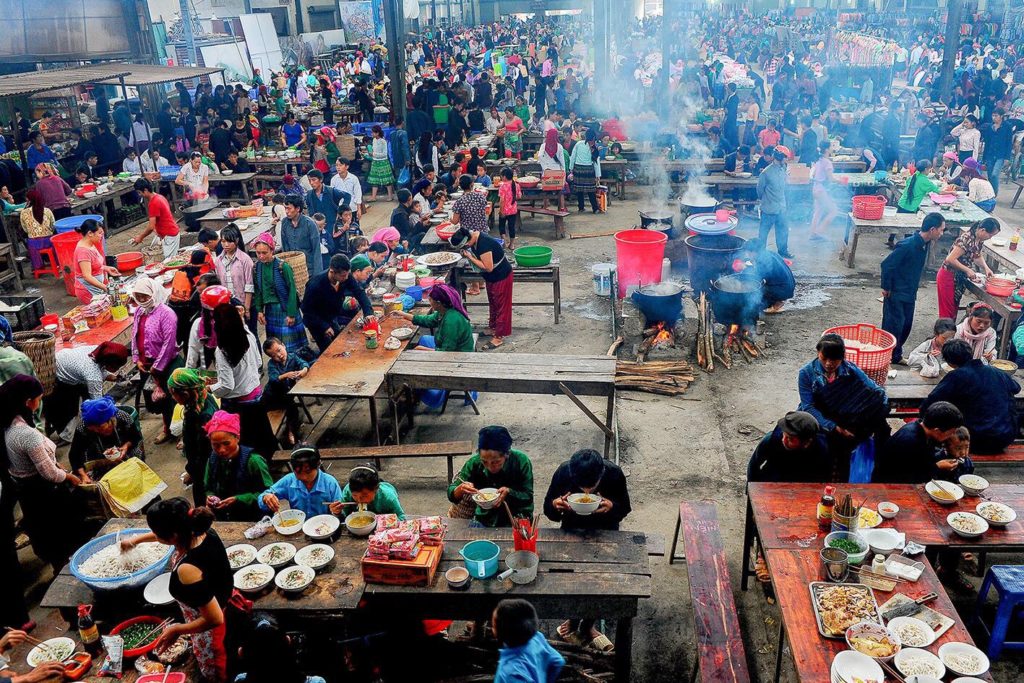
Situated in a valley bordered by mountains, Meo Vac Market operates every Sunday, standing out as one of the best and most unique traits of Ha Giang Tourism. Domestic and foreign tourists find it very interesting to attend this colorful ethnic market and observe the locals’ trades, their costumes, and goods exchanged. On Sunday, the Hmong family members will go to the market; they could bring their products, animals, and food for sale. The popular animals to be sold include the wild pigs and the mountain goats. There is also a wide range of costumes, brocades, wine, and food on the spot. The market atmosphere is so exciting and dynamic that people are eager to sell and exchange their items. As guests, you can buy some iconic products of the mountains if you like, or simply watch and feel. The onsite experience is so enjoyable that one can forget.
Lung Cu Flagpole

Located at Lung Cu peak, the national Lung Cu flagpole represents the pride of Ha Giang province as it is a symbol of the northernmost point of Vietnam. From this spot, it’s feasible to see the Chinese land border. At an elevation of 1,700m above sea level, the flagpole provides an awesome view of the scenery beneath. You can also view the two lakes on the mountainous sides, which are called the “dragons’ eyes” by the locals. The lakes serve as the critical source of water for the ethnic minority villages. The travel to Ha Giang should be as unique and exciting as expected if you spend the morning time reaching the Lung Cu flagpole and capturing the moments you’re there. The walk toward the flagpole is scenic and the morning fresh vibe will give you the energy. Note that the flag is 54m wide, representing 54 ethnic groups in Vietnam.
Quan Ba Mountains – Heaven’s Gate
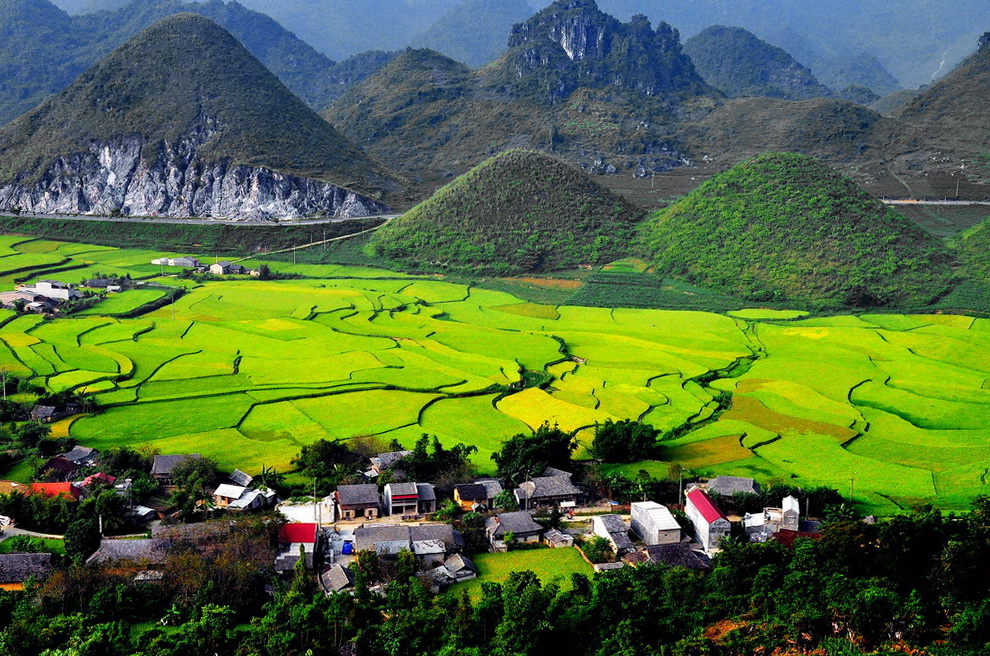
Not only do Quan Ba Mountains win visitors’ interest in its interesting shape and green cover, but it’s also about a local legend. That said, there was a Hmong man being so good at playing trumpet by his lips that his sound could reach a beautiful fairy’s love. The fairy came to the earth to see the man, and then they lived together happily. Later, the couple had a baby boy. Nonetheless, the fairy’s escape was considered wrong, and she was forced to return to heaven. To raise her son, the mother decided to leave her nipples which helped the boy grow up. Magically, the two nipples turned into the twin mountains. With the lush beauty and fresh vibe, this area becomes an attractive ecotourism landmark for any tourists getting to Ha Giang. The mountain is around 40km from the town. Don’t miss heaven’s gate, a popular check-in spot today for the young backpackers. If getting there in the winter, you might encounter mist. If the sky is clear, the sightseeing opportunity is awesome.
Yen Minh Pine Forest
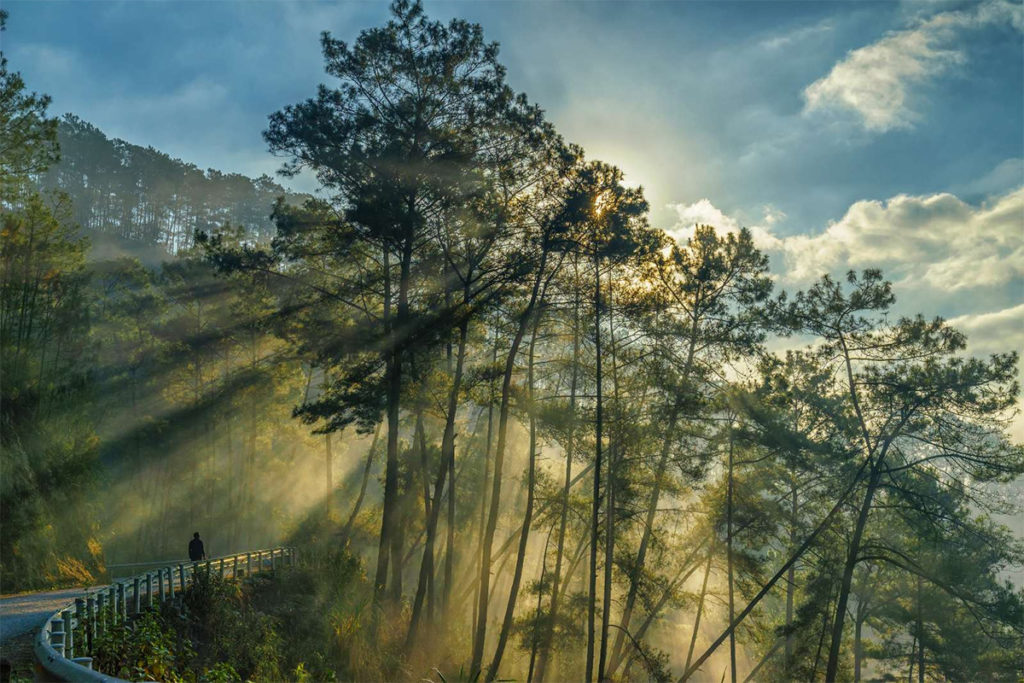
Passing Quang Ba mountains around 40km and through the winding roads, you’ll arrive at the astonishing Yen Minh pine forest. This landmark is called the second “Da Lat” of Vietnam thanks to the lush ambiance and cool climate. The site is very photogenic while the pine forest is so high and lush that establishes a masterpiece of nature. Amid the blue sky is the green pines that harmoniously create the natural landscape for awesome nature photography any time of the year. The site is also perfect for pre-wedding photography. Or if you like trekking, this forest is surely a place to venture out and fulfill your passion for a happy trek. The straight pine trees with green leaves are the beautiful components to feast on the eyes. Despite the wind and rain, the trees still grow and present their best beauty. It’s a venue to heal the lung with fresh and cool air. In addition to the green beauty, from the forest, you can spread your eyes toward the roofs of the Hmong houses behind the mountains. The immense grassland also urges you to treat the ears nicely via the birds’ songs and the sounds of the pine forest. In some corners, you might notice the red flowers blooming, which adds color to the green land. This is a perfect treat for the eyes too. A visit to Yen Minh Pine Forest in Ha Giang is a healthy journey for both mind and body. People do enjoy camping and a picnic at this ecotourism site.
The Hmong King’s Palace
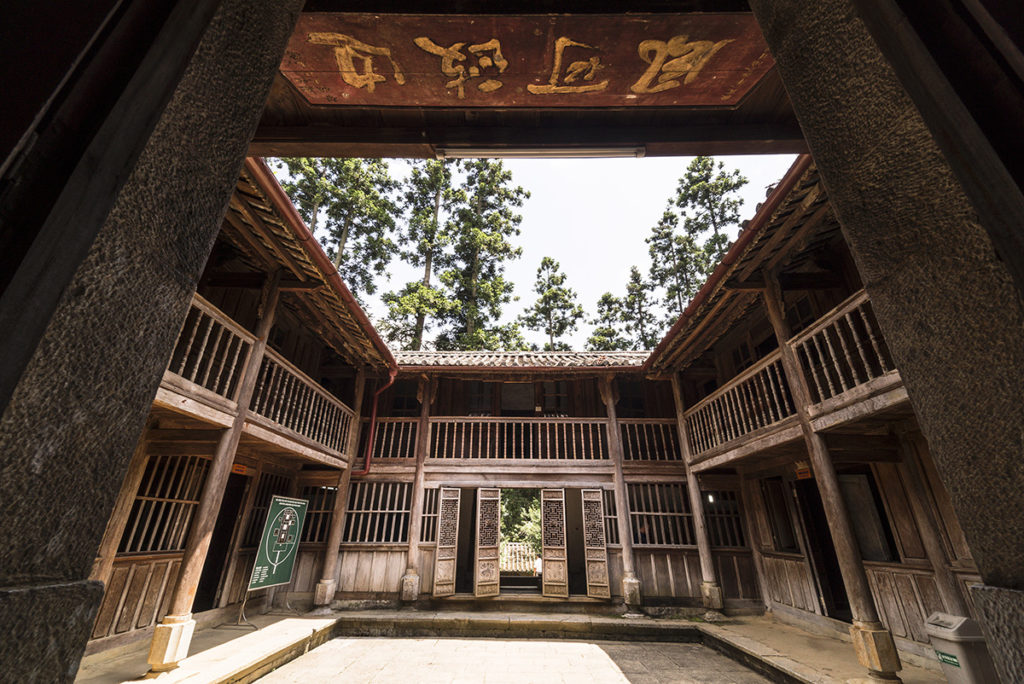
The palace of the Hmong King or the Vuong Family’s Palace is situated in Sa Phin Commune, around 24km from Dong Van district. It preserves exceptional and impressive architecture. The palace is bordered by two stone walls and consists of 10 houses; of which the 6 hours are in the same direction while the other four are in the other direction. Houses were built from precious wood and modeled on the Chinese architecture of the 20th century featuring curves and sophisticated carvings. Besides, it featured a fine combination of the Hmong and French architectural details. The campus of the relic site is approximately 3 hectares wide. The whole palace is open for tourism nowadays. Visitors enjoy listening to the story of the Hmong King – Vuong Duc Chinh who was respected by the Hmong ethnic group as he gave them food and independence during the French colonial period. Witnessing the old architecture is a great experience for the history buffs. Also, taking pictures inside the palace is a not-to-miss activity. In 1993, the Vuong Family’s Palace was recognized as a national architectural and artistic relic. If you’re keen on the mansion of the old Hmong king, this architectural masterpiece is precious enough to pay a visit.
Sung La Valley
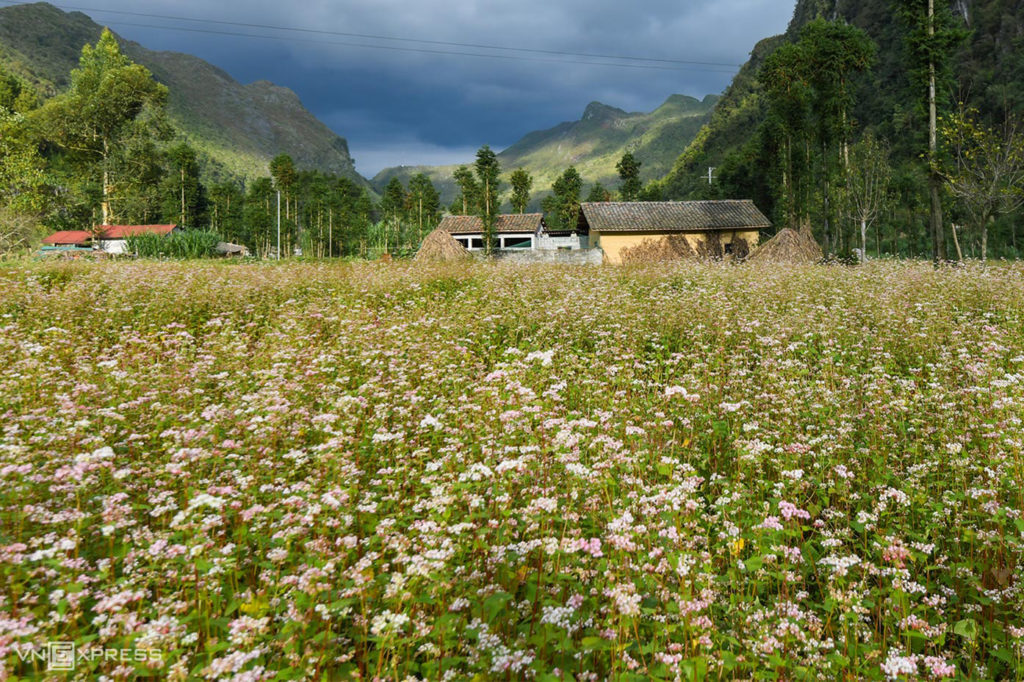
The Sung La Valley is located Dong Van district and is known as the heaven of various highlands flowers. The fields and mountainous slopes in this area are covered by buckwheat flowers, yellow cabbage, roses, etc., and the most outstanding are the buckwheat flowers. This valley is where you can find the most beautiful buckwheat flower field in Ha Giang. Together with the flowery landscape, make sure you don’t miss the “Pao’s House” which is unique and has typical characteristics of Dong Van houses. The Pao’s House has stone walls and ancient architecture. It’s bordered by a series of pretty flowers which look photogenic.
Ha Giang in Northern Vietnam Tours:
Introduction to Ha Giang ’s Best Accommodations
Phoenix Ha Giang
Located in a strategic location, Phoenix Ha Giang is the first hotel of the 4 stars in the city. It has a system of 140 rooms, which impress visitors with the neo-classical style and each room is designed with open windows overlooking the poetic Lo River. Along with that, the dedicated staff and professional customer service in this place promise a great holiday awaiting you in Ha Giang. For a sense of a bit of luxury, do yourself a favor by booking a room in Phoenix Hotel.
Dinh Gia Ha Giang Hotel
Being ranked highly and nicely on the room booking sites, Dinh Gia Ha Giang Hotel is a 3-star accommodation situated in the center of the city, nearly 200m from the coach station. The hotel has a good reputation regarding the room quality and qualified services served by the friendly staff. The facilities of 3 stars, conference room, restaurant, karaoke, etc., make your stay comfortable and energetic enough for a day of exploration. The hotel also assists guests in hiring a motorbike or booking a taxi. Therefore, you’re likely to meet many Vietnamese tourists staying at this address.
Hmong Village
Situated at the gateway to the Dong Van Karst Plateau Geopark, the Hmong Village provides a unique resort atmosphere welcoming the domestic and international tourists. In addition to the ethnic-style houses, this address has 15 hours modeled on the baskets on the backs of the Hmong girls. These basket-modeled houses were confirmed by Vietnam Record as the “Resort with the “Quay Tau” houses first built in Vietnam.” The site also offers an infinity swimming pool with thousands of Instagram-worthy corners. It’s amazing to release yourself into the transparent water and observe the picturesque mountainous landscapes in this 20-ha resort.
Ha Giang Historic Hotel
Ranked as a 2-star accommodation, Ha Giang Historic Hotel pleases guests through its good services and interesting design. On a spacious campus, guests can enjoy biking around the site and note that the restaurant and bar are separated from the resort area. Such design helps ensure a quiet atmosphere for guests to have a good rest while providing a dynamic environment for the thrill-seekers to chill out and play excitingly without a need to worry about anybody’s complaints. The room is well-equipped enough to give you a sound sleep.
Hoang Su Phi Lodge
Offering the best mountainous view, Hoang Su Phi Lodge is usually included on nature lovers’ bucket lists. The lodge is set amid the beautiful terrace rice field, which impresses people with the giant atmosphere and a system of stilt houses modeled on the Red Dao’s houses. The use of raw materials like bamboo and kinds of wood creates mountain-style bungalows for you to feel the complete ambiance of the destination. There might be nowhere on earth to surround yourself with the scenic nature, rice fields, and ethnic houses like this. The best months to stay in Hoang Si Phu are September and October when the whole region is illuminated in a golden yellow during the rice harvest.
Ong Vang Meo Vac
Ong Vang Meo Vac is among the best hotels in Ha Giang at the most reasonable prices for couples. The little hotel is located in Meo Vac town, which is feasible for going to the other landmarks. Like its name, the hotel rooms are in the yellow beehive design and put on the green campus. Each room is equipped with essential furniture and provides a private ambiance for couples. Along with the room for couples, this accommodation also has a 100-year-old house, which is suitable for a group of seven guests or those who want to experience the living zone of the ethnic people.
Meo Vac Valley Hotel
Located at the foot of Ma Pi Leng Pass, around 2km from Nho Que River, the Meo Vac Valley hostel is one of the cheapest accommodations for all backpackers. This address has been reviewed by bloggers, who appreciate the romantic and picturesque view from the hostel. Also, the ethnic food served at this address is a great score. This is where people feel and experience the Hmong culture and lifestyle. The surrounding nature is so pristine and fresh that helps you stay stress-free. Its location is ideal for getting to the other local landmarks, which somehow explains why many tourists enjoy their stay in Meo Vac Valley.
LoLo Eco House
Situated nearby the Lung Cu flagpole, LoLo Eco House is a perfect accommodation to enjoy untouched nature and the well-preserved culture of the ethnic minority group. Standing out of the lush green atmosphere is the wooden stilt house design like the traditional houses of the Lo Lo ethnic group. It provides a harmonious combination of ethnic architecture and the wild natural landscape of the northernmost area. At this address, you can enjoy tea in the early morning and admire the Lung Cu flagpole.
Introduction to Ha Giang’s Best Food to Eat
Chao Au Tau (Au Tau porridge)
The porridge is cooked from glutinous rice mixed with plain rice while the “Cu Au Tau” (its scientific name is Aconitum Fortunei Hemsl) is carefully simmered with greasy pork legs and some herbs. Not only does this specialty serve as food, but also sustenance to relieve the cold. The “Cu Au Tau” must be washed carefully, and then soaked in the rice water overnight before being simmered for 4 hours to be soft and mushy. The complex is then mixed with rice and cooked in the pork broth. Know that this kind of tuber is toxic, so it must be processed with knowledge and care. The porridge might taste bitter and is usually sold in the cold evenings. A hot bowl of porridge topped with minced pork, chili, pepper, egg, etc., can make you hungry and want to slurp. The light brown porridge is a great remedy for a cold night; it’s good for health and helps prevent joint diseases.
Thang Co (horse meat soup)
In any talk about Ha Giang food you must eat, it cannot help mentioning “Thang Co”, a kind of horsemeat soup. This traditional food has been present in the ethnic markets at weekends and in the food stalls around the Dong Van market areas. The fragrant smell and hot bowl of the horsemeat soup are a must-have in Ha Giang. The original version is made from the meat and organs of the horse. Other modified versions might use beef or buffalo meat instead. The meat and organs will be made clean and then mixed with a variety of local spices. The marinated complex will be put into a pot of bone broth for steaming until it gets tender. When eating, you can eat “Thang Co” with some salt and chili to enhance the flavor. Additionally, it’s great to drink with corn wine on cold days.
Reu Nuong (grilled moss)
The grilled moss is a specialty of the Tay ethnic group. The moss is not generally considered food by the Vietnamese, but in the Tay group’s belief, it is an attractive food and only this local group knows the secrets or the keys to creating the best version. The cooking procedure requires the locals’ special knowledge and skills. The fresh moss should be green and grown for 3-4 days. After being cleaned, they will be mixed with the mountainous spices. Then, the complex will be grilled for an unforgettable taste. The grilled moss is one of the unique highlights to discover during your journey in Ha Giang. You might not find this food elsewhere, so take the opportunity to know how it is!
Banh Cuon Trung (egg roll cakes)
This is a specialty of the northern province that every guest is welcomed to savor. The cake features a thin layer of dough, which includes the fillings of minced pork, egg, mushroom, etc. You might find its versions throughout the northern cities like Hanoi, Hai Phong, and Lang Son, but the one in Ha Giang tastes different. Ha Giang rolls should be dipped in the sweet bone broth and topped with fried shallots and some herbs. It is a perfect choice for breakfast.
Pho Ga Trang Kim (chicken noodle soup)
Trang Kim chicken noodle soup is a common breakfast of the Hmong, especially during the weekend markets. The food is made from the mountainous chicken raised by the Hmong people, so its meat is very nutrient. A special trait of the local chicken noodle soup is that soft noodle which is processed and dried manually. Also, the broth is stewed from the chicken bone and other spices like ginger, cinnamon, etc., resulting in a sweet taste and appealing aroma. A bowl full of noodles topped with the shredded yellow chicken pieces will win your palate for sure.
Banh Tam Giac Mach (buckwheat flower cake)
Banh Tam Giac Mach is an iconic cake of the Hmong groups who live in the stone highlands. The cake-making procedure covers many steps, from harvesting the buckwheat flowers to drying and grounding them until they become smooth flour. The light purple flour is then mixed with water and molded into flat round pieces for steaming. Once served, the cakes could be baked or fried for the fragrant and sweet taste, which is the rustic flavor of the mountains.
Thang Den
Thang Den is a kind of sweet soup, which is one of the best-sellers in Dong Van market in the evening. The dish is made from the high-quality glutinous rice of Yen Minh, which has been famous for its soft and aromatic taste. The rice is made into balls of different colors, which can be white, purple, orange, yellow, etc. When eating, the balls are put into a small bowl, which is later mixed with Hoa Mai sugar water and added with roasted peanuts to level up the culinary experience. The sweet soup is a perfect choice to warm up a cold night in Ha Giang, especially during winter days.
Com Lam Bac Me (bamboo rice)
This version of bamboo rice is a traditional dish of the Tay ethnic group. It features the unbeatable fragrance from banana leaves and grilled bamboo pipes. You can eat the rice with sesame salt and grilled stream fish for a complete meal of the highlands. Anytime you feel hungry, the Ha Giang bamboo rice stands out as a great food offer to fulfill your stomach pleasantly. Don’t miss a chance to try the hot bamboo rice pipe and tell how different it is. Eating the “Com Lam” with the grilled stream fish gives you a real culinary experience like the ethnic people.
Banh Chung Gu (a kind of sticky rice cake)
The sticky rice cake is wrapped manually by hands and its crust can be either blue or black, depending on the type of rice used. The fillings have green bean paste and seasoned bacon. “Banh Chung Gu” is the traditional cake of the Red Dao ethnic group. The cake is in a small size, which just fits a palm. Its name is inspired by the images of the local women wearing a basket full of cakes on their backs. You can consume this cake as a snack during the day or buy several as the must-have local souvenirs. The recommended address to buy the sticky rice cake is Meo Vac market. Note that the market atmosphere gets busier during weekends when the prices seem to be cheaper than on weekdays due to many ethnic people’s presence.
Xoi Ngu Sac (five-colored steamed glutinous rice)
Xoi Ngu Sac is an authentic dish in Ha Giang, which is famous for its beautiful colors and sweet taste. The five colors are white, red, green, purple, and yellow, of which each color represents the Five Elements of Wood, Fire, Earth, Metal, and Water. The colors originated from natural ingredients; white is from steamed rice, red is from “Gac fruit” (sweet gourd), green is from ginger leaves, purple is from magenta leaves, and yellow is from turmeric. Once served, the dish is decorated as a five-petal flower, a multi-floor tower, or a multi-colorful terraced rice field. The sticky rice is often present in the local fairs of Ha Giang. It looks colorful, smells nice, and tastes amazing. Also, the food is cheap and portable so you can have it as a snack anywhere you go. The five-colored steamed glutinous rice is a must-have in the local festivals and significant events offered to ancestors to show their gratitude and respect. In return, they pray for bumper crops, good health, and happiness. So, don’t miss an opportunity to enjoy this sweet sticky rice in Ha Giang, study its five colors, and evaluate the taste.
Introduction to Ha Giang ‘s Future Orientation
The northernmost Ha Giang Vietnam serves as a borderland of the country filled with majestic natural landscapes, geological values, a cool climate, and the culture of ethnic minorities. These are great potentials to help promote tourism in this untouched destination. Numerous guests have been traveling to Ha Giang, taking pictures at the Km0 attraction, and others, which prove that Ha Giang has its charm to attract tourists nationwide and worldwide. Tourism development also helps change the locals’ lives and economy by creating hospitality jobs. In 2021, Ha Giang was included in the Top 10 Destinations in Vietnam ranked by CNN. Its orientation is to focus on sustainable tourism development with a vision for 2030 besides the conservation of Dong Van Karst Plateau Geopark as well as preserving the traditions and culture of the ethnic groups in the area. The natural landscape and environment should be protected carefully too. Oriented to 2030, Dong Van Karst Plateau Geopark will be recognized as a national tourist site. Also, the introduction to Ha Giang ‘s tourism will focus on geology, ecotourism, ethnic culture, and resort. Its brands cover two highlights. First, it is the northernmost province with magnificent mountains and enchanting terraced rice fields for diverse and challenging experiences. Second, it is home to the friendly and happy ethnic minority groups who preserve their culture and tradition in daily lifestyle despite the harsh weather conditions.

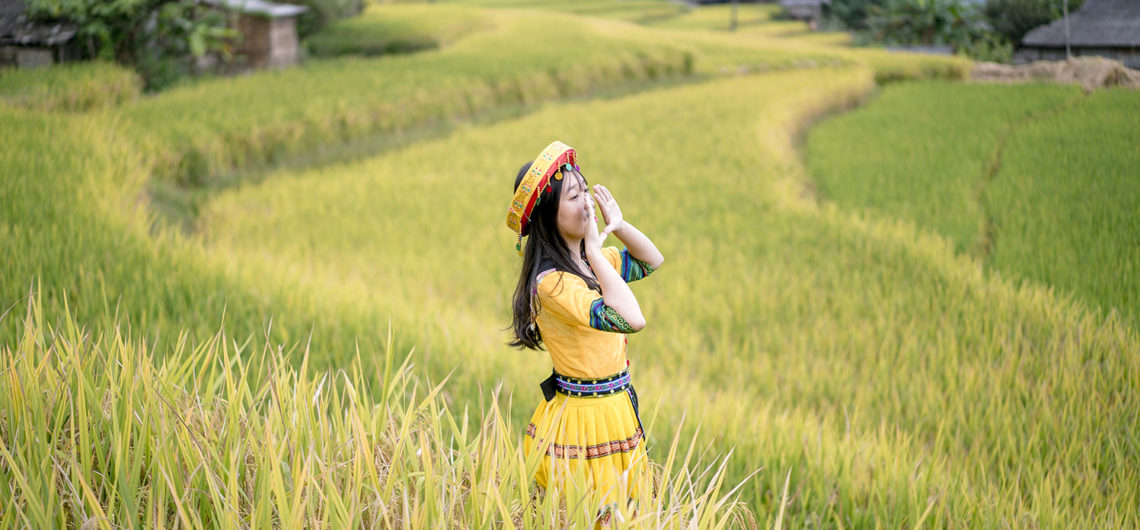
Comments